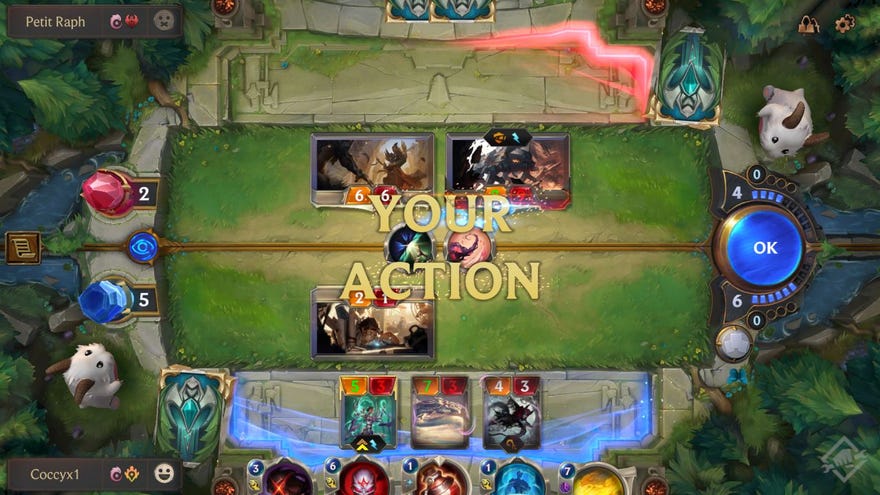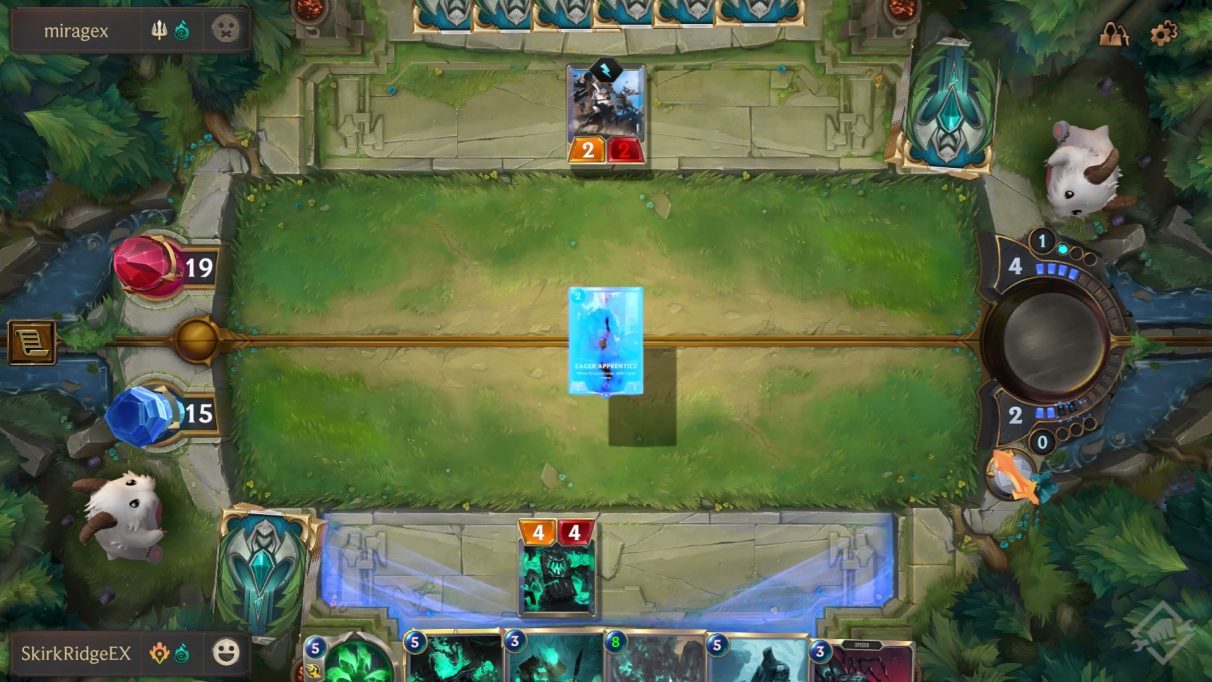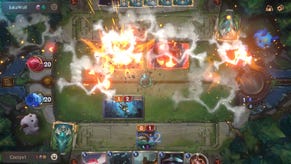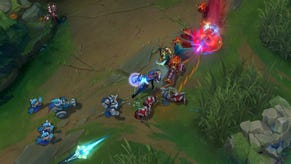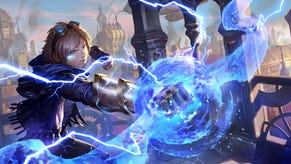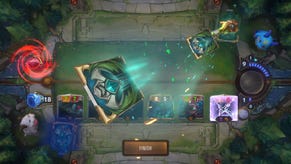How Legends of Runeterra's rounds work
How to stack cards
Rounds in Legends of Runeterra are perhaps the most complicated thing to get your head around. It relies on understanding the logic behind how spells resolve, when you can play certain cards, and actions that can take place during combat phases. A lot of how Runeterra works is dependent on understanding a concept Magic players would be familiar with. Let us guide you through how turns work in Runeterra.
Legends of Runeterra rounds guide
Cards are played in Legends of Runeterra in a certain sequence of events. Our Legends of Runeterra rounds guide will explain how each round in the game works, as well as explain how cards resolve in the game. It's one thing to check out our Runeterra best decks guide and crafting decks that can dominate opponents, but knowing How to Play Legends of Runeterra is key to winning tight games.
Runeterra rounds guide contents
- The Stack
- Beginning of round actions
- Summoning champions and followers
- Casting spells
- Attacking phase
- Ending the round
The Stack
In order to explain how rounds work as succinctly as possible, I'm going to borrow a term that is regularly used in Magic the Gathering called "The Stack". This is one of the more difficult things to explain to new players, so I'm going to use a few examples to ensure that the concept really sticks.
I want you to grab some playing cards. Any will do, it can even be cards from something like the children's board game Guess Who. Take a card from the top of the deck and place it face up. Now take a second card and place it on top of that one. Do this one more time and you'll have a small pile of three cards. Note that the stack can be larger than this, but for this example it's easier to just keep it to three.
Now set your deck of playing cards aside and look at the pile you've made. The top card is card number 1, the middle is card number 2, and the bottom card is card number 3. This is despite you drawing card number 3 from the deck first and card number 1 last. This is the basic concept of the stack.
Extra Credits made an excellent episode dedicated to how the stack works in Magic the Gathering and I think it's a fantastic way to learn this rather complex concept. In Legends of Runeterra, it works in almost exactly the same way. Spells, Champions, and Followers initially appear in the middle, but each Fast spell is added onto the stack is added to the left of the stack.
The key difference in Legends of Runeterra is that by playing a Burst spell, it resolves immediately and you can take another action if you have the mana and Fast/Burst spell cards to play them. Once both players have declared that they have finished putting spells on the stack though, they resolve from left to right. You can not play any more Fast or Burst spells once the stack begins to resolve.
With that explanation out of they, let's begin talking about rounds in Legends of Runeterra.
Beginning of round actions
The following actions take place at the beginning of every turn. They can not be interrupted in any way:
- Both players simultaneously refill all mana spent and gain an extra mana gem, up to a total of 10. If you had up to three remaining mana at the end of your last turn, this is put into the spell mana allocation for this turn.
- Both players draw a card. Players have a maximum hand size of 10 cards with any extra cards fizzling away.
- An attack token will appear in the attack token slot of the player who didn't attack last turn. This does not take into consideration any cards with"Rally" that were played the previous turn.
- The player with the attack token will now be able to act first this round.
Summoning champions and followers
Champions and followers are played at any time you can play a slow spell. They can't be played during combat or while an opponent is playing a spell. Champions and followers are played onto the stack.
- The player casting the Champion or Follower card put it on the stack, paying for its mana and other associated cost.
- The other player has the opportunity to respond with Fast or Burst spells. If a Fast spell, it is put to the top of the stack. If a Burst spell, it resolves and they can potentially play more cards.
- If the other player played a Fast spell, the player casting the champion can play a Fast to the stack or a Burst spell instantly in response. Priority passes back to the second player if they cast a Fast spell.
- Once both payers have declared that they have no more spells to play, the stack resolves from the leftmost card to the right.
Casting spells
Spells work in a similar way, but you will need to take the speed at which spells are cast into consideration.
- Check to see if the spell is a Burst spell. If it is a Burst spell, it immediately resolves and the mana cost is paid. The casting player can then cast more champions/followers/spells as per normal.
- If the player is casting a slow spell or fast spell, it is put on the stack, paying for its mana and other associated cost.
- The other player has the opportunity to respond with Fast or Burst spells. If a Fast spell, it is put to the top of the stack. If a Burst spell, it resolves and they can potentially play more cards.
- If the other player played a Fast spell, the player casting the champion can play a Fast to the stack or a Burst spell instantly in response. Priority passes back to the second player if they cast a Fast spell.
- Once both payers have declared that they have no more spells to play, the stack resolves from the leftmost card to the right.
Attacking phase
Attacking in Legends of Runeterra is initiated as soon as the attacking player has priority. Here's how combat works:
- If a player has an attacking token, they spend it by dragging allied units into the battlefield. You can place them in any order and play Fast/Burst spells. Burst spells resolve immediately while Fast spells are put onto the stack. If any of your attacking units have the Challenger ability, you can also drag your opponents to block you at this point.
- Once the attacking player has declared attackers and which defenders have been dragged in to block attackers with the Challenger ability, the defending player can assign blockers and play spells onto the stack.
- Once blockers have been assigned, the attacking player gets a chance to respond by casting Fast or Burst spells. Spells are added and removed from the stack as per the Casting Spells order explained above.
- Once all players have finalised their actions, the stack resolves, then combat damage occurs. Quick Attack and the first Double Attack damage phases happen first, then regular strike damage and the second Double Attack damage phase happens. Surviving units are then removed from the battlefield and placed on the bench, while those reduced to zero health are considered dead. Priority then passes to the defending player.
Ending the round
Once both players have passed priority in the main phase and there are no spells on the stack, the round is over. The beginning of round actions now happen once more, but this time with the player who didn't get the attack token becoming the first player.
And there we go! That should make how turns work in Legends of Runeterra a lot easier to understand. Do make sure to check out the rest of our guides below.
Legends of Runeterra guides links
- Legends Of Runeterra guide - Tips and tricks to get started in Legends of Runeterra.
- Runeterra best decks - The best decklists currently available for Runeterra.
- Runeterra ranked mode - Explore how ranked mode works and what rewards you get for participating.
- Runeterra Expeditions - Learn Legends of Runeterra's draft mode and see which cards are the best.
- Runeterra champions - Find out what each champion does and how to level up.
- Runeterra cards list - All of the follower and spell cards in Runeterra.
- How to Play Legends of Runeterra - Learn how to play the game, what cards do, and the turn order.
- Legends of Runeterra Ephemeral tutorial - Step by step instructions to complete this bothersome tutorial.
- Runeterra vault - Quick ways to gain XP and open better weekly vault prizes.
- Runeterra keywords - All the keywords and major interactions in Runeterra explained.
- Runeterra player icons - Steps to change your player icon.
- Runeterra guardians - If you bought guardians, here's how to change them.
- Runeterra boards - Those who have spent money on boards can learn how to change them here.
